- Final Fantasy Best Buster Sword Replicas - January 30, 2023
- Final Fantasy Tifa Lockhart Guide: Inner Strength - December 31, 2022
- Omega Ruins FFX Guide - April 16, 2022
The Game
(FFT) is a stand-alone story about the history of a country called Ivalice. Where a commoner long ago once became King as a hero during the War of the Lions, and a heretic vanished into the mists of time after taking down the most powerful church figures in the country.
The takes you into this significant historical time after setting the scene, and lets you take part in this timeline, not as the commoner who united a warring land, but as the heretic.
FFT is also the very first dive into the tactical RPG genre the FF series attempted. They didn’t rush, making sure to enter the genre as strongly as possible. It ended up being a great success. The gained a plethora of positive reviews and feedback from fans and critics during its initial release on the 1.
Even later, being re-released on the PSP(re-mastered with multi-), and is now available for the phone as an app. It continues to be enjoyed by new players and garner new fans.
I would say it’s proven to be one of those rare, age-defying games, in the history of modern gaming. Something especially impressive from a Tactical RPG, a much less mainstream genre than say a platformer or a first-person shooter.
What is a Tactical RPG?
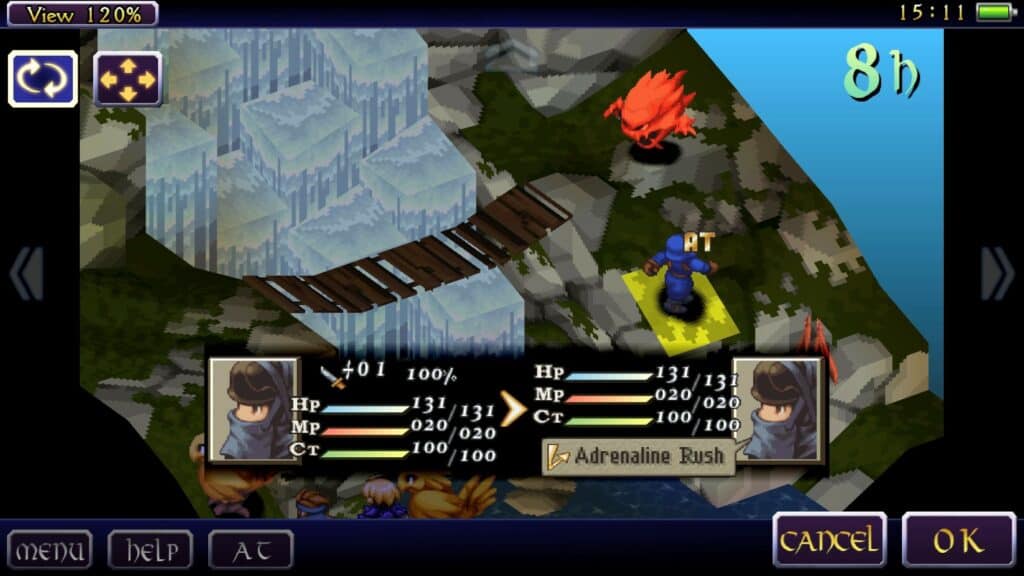
A Tactical RPG is a turn-based, -driven genre that requires team building. There’s a lot of reading, usually in dialogue boxes, to move the plot forward and establish relations.
Maps in a tactical RPG are divided into movement spaces, usually squares, like a tabletop . Your characters move through each square during their turn equal to the ‘s movement point system. Terrain, like trees, mountains, and rivers, often tends to play a part in how you adjust your strategy for each encounter.
A tactical RPG comes down to your to plan, prep, and make careful choices with the field presented before you. Each is developed by you as they level up through . You have control over what skills they use, the equipment they wear, and the team you take into combat.
These are not games in which you need to rush to action, nor that requires you to be nimble with your hand-eye coordination.
They can punish a who attempts to hurry through them by relying on basic attacks and not trying to understand weaknesses, classes, or that doesn’t strategically approach more difficult combat scenarios.
It’s a thinker’s genre with a hint of action and is commonly story-heavy.
Tactical RPGWhat Sets FFT Apart?
Unlike many tactical RPGs, it moves a bit faster. It balances the gameplay with the story well, so as not to leave a reading for 30 minutes with nothing to play.
Its story is very well-paced thanks to this and greatly adds to the experience of the overall . In fact, let’s delve into that now.
The Story
FFT presents the medieval genre with a setting in its darkest hour. Family murdering family for power, lords using the church and propaganda to manipulate people.
Wars that leave the valiant poor and hungry and the violent wealthy and rewarded. This storytelling makes it a standout amongst RPGs that usually keeps the wrongdoings for the main villains of the .
FFT lives in the same gray area that our medieval history does. Its heroes and the choices they face are not always simple or right. Its characters are presented very honestly. They don’t do things simply to progress the forward but are instead forced to respond to the things happening in a world amid great change.
Ramza Beoulve
You play Ramza, the youngest son of a noble family known as House Beoulve. You have two older brothers and a younger sister, Alma.
Your father was a war hero, and in a short cutscene, you get to bid him farewell as he dies from an “illness”. Life is a little tough, but nowhere near the worst. Ramza’s care for others is what drives him to be the hero Ivalice needs.
Delita Heiral
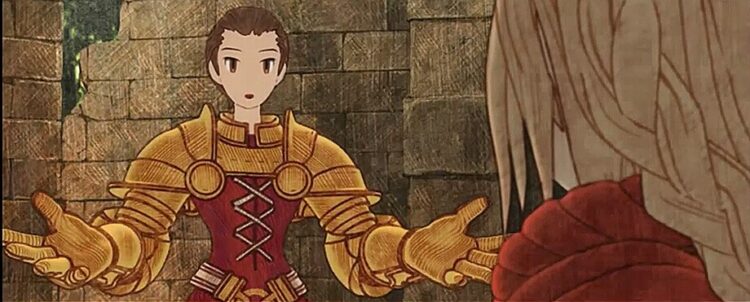
The second most important character is Delita. He has a sister, Tietra. They were both adopted by Ramza’s father. For Ramza, that makes them family.
When Delita’s sister gets kidnapped, Ramza learns his own family doesn’t live up to the kindness that his father passed down to him. Delita is forced to face and adapt to the harsh truths of the world, and he becomes the hero Ivalice deserves.
Soon betrayal, confusion, and death tear their worlds apart. Setting the stage for the two narratives that drive our story forward. That of Ramza and Delita. The heretic and the future King.
Tells Some Amazing Arcs
It’s the kind of story where you may come to hate characters you liked and like characters you hated.
The choices of nearly every are shown in how they matter to that individual, even if it’s giving their soul up for power so they can get revenge on you for killing someone who gave you no choice because of who you were fighting for. So. Wonderfully. Complex.
It does trek into the Fantasy realm of its title pretty hard. Magic and summoning are basic skills and are accepted as normal jobs in this world. Skeletons and Ghosts are normal encounters.
Delita fights the more realistic, uphill against greedy Lords and Dukes to position himself so he can “save” Ivalice. Doing whatever he has to, in order to achieve their downfall.
All the while Ramza and his collection of ragtag heroes the physical manifestations of ancient demons and get caught in the struggle for the soul of Ramza’s sister, Alma, against a literal God!
Don’t worry, they avoid the easy cliché of friend vs friend. Ramza and Delita are never truly against each other. Before I wrap up the story section, let me talk about a scene that is vividly branded in my memory.
When Delita’s sister gets kidnapped, a named Argath tells Delita and Ramza that House Beoulve is going to let her die. That Ramza shouldn’t spill a drop of his blood for that ‘common’ girl. Delita storms off and Ramza warns Argath to leave or he might very well kill him.
Later on, Ramza catches up to Delita in a field. It is here the two of them share the last peaceful moment they’ll get for a long time.
“Remember how father taught us to play the reed flute?” Delita says to Ramza.
Then, as simple as that, they each grab a strand of reed from the ground and play together.
The writers here do something I cherish in a heroic tale; they make the larger-than-life heroes, just people. The two brothers are mourning their father, they are scared for their sister, and they need comfort like the rest of us. They can handle all this stress with hope because they still have each other. I never forget that feeling.
At that moment I was Ramza, I wanted to save Tietra. I wanted to tell my friend, Delita, Argath was wrong. I feel it—every single time.
The Graphics
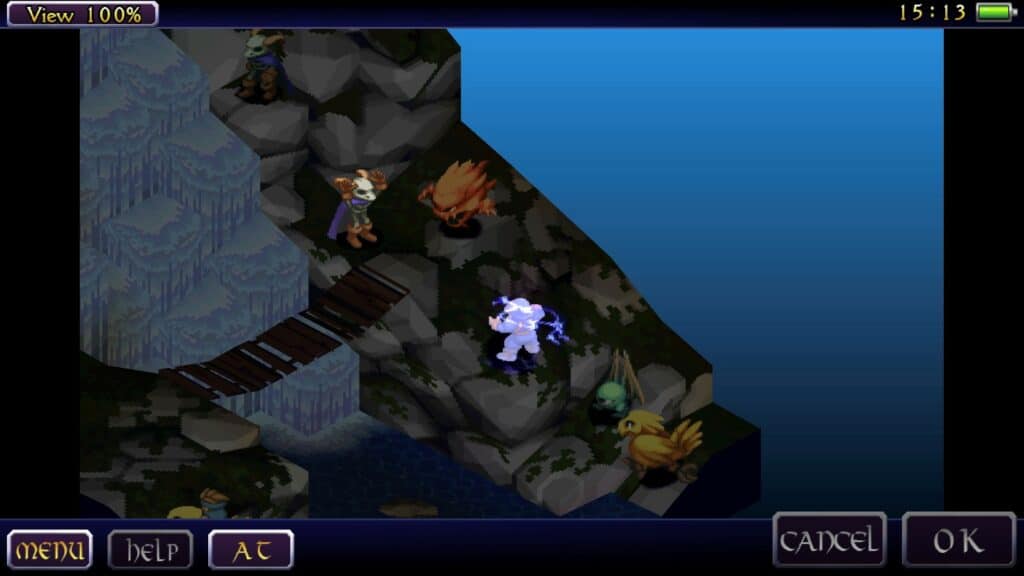
These age well for one very specific reason. They didn’t overdo them.
The developers chose to focus on well-shaded, clear map designs and simple easy to recognize sprites and skill effects. Opposed to seeing how fancy they could get with the technology of the time. This makes it easy on the eyes, and never confusing in regards to what’s going on during combat. Some of the spells are even charming, using great sound effects to add to the mood of their casting. Like Holy or one of the many Summons.
The re-mastered version has beautifully hand-drawn cut-scenes and voices added throughout.
Though it did upgrade most of the original dialogue with better grammar and add a new class, , there were a few changes I don’t like as much in the current version.
“When your father taught us how to whistle with a blade of grass?” Is the line that replaces my vivid memory of the earlier scene, for instance. It’s still a good moment, but something about saying ‘your father’ instead of just ‘father’ doesn’t work as well for me. The overall story is intact.
The Music
It’s very much classical music used throughout. Tremendous highs and lows and great composition fit each story beat.
All the games do grab up some of Japan’s greatest composers.
The Gameplay
FFT applies simple mechanics that have an easy learning curve and give each plenty of room to be creative.
The World Map
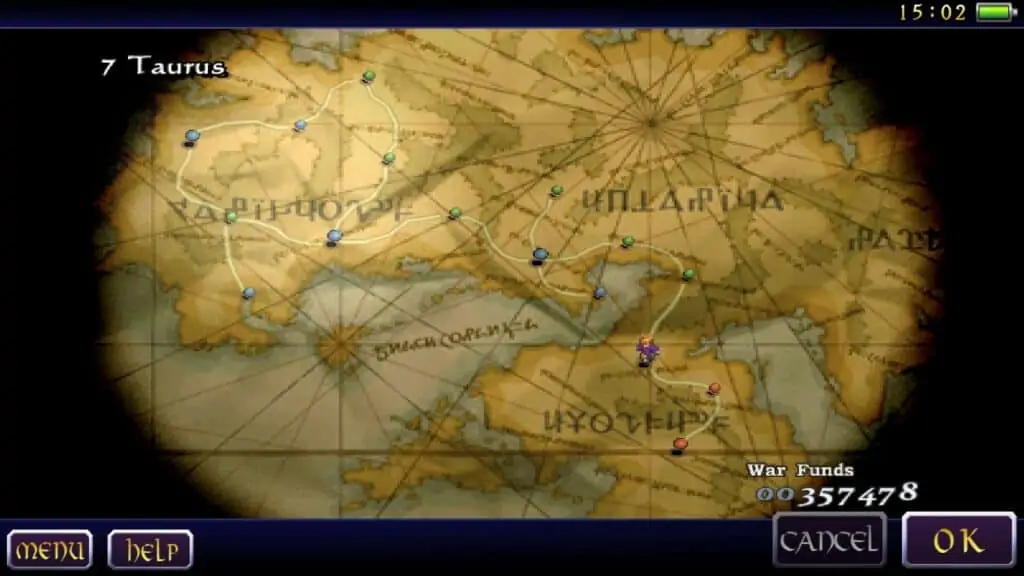
You have an overview map, with new locations that pop up as the story and progress for you to explore. A cute little version of Ramza strolls about it when you select where to move. You do have to cross over EVERY location in-between points. So, knowing what these Final Fantasy locations are is helpful.
Some of these locations will be in red, which is a guaranteed battle and will usually move the story forward. Always SAVE before entering a red location.
Some of these locations are green, which indicates you can be randomly attacked here. The enemies will always be at the same level as your team’s average. There is no low-level farming area.
The last color of locations is blue, these are usually cities. A few are not, but those few are still safe spots for you to move over freely.
Cities are where you get your items and equipment, like most RPG titles. In Final Fantasy Tactics, cities also have taverns. Here you can take Errands to send some of your teammates out for work.
They come back with money, increase their job points so you can teach them new skills, and can even unlock secret side quests, unique artifacts with world lore, and/or hidden map areas.
Make sure to always check Rumors in every city, even if you don’t want to read them, just checking them and pretending to read them can open up new Errands and Secret Quests.
You can also recruit new teammates if you need them from the Warrior’s Guild. Female or Male, as you prefer. Males have a higher base attack and Females have a higher base magic attack, on average. HP and MP are mostly similar if only slightly random.
Different cities also sell different items! That’s important. You can’t get Knight Swords, Heavy Armor, bows, or crossbows at a merchant city, you have to go to a castle.
At most merchant cities you can get Rods, and the lighter armor used for other classes. Little details like this add a nice sense of realism to the map without making it too complicated.
Aside from this, the overview map lets you access the in-game menu.
The In-Game Menu
The In-Game Menu has quite a lot of functions in FFT. Importantly giving you the option to Save and/or Load a previous game by selecting, Data.
It has a Tutorial option, in case you are having any difficulties understanding parts of the game. Like how healing magic damages the Undead enemies, or how fire magic heals the enemy types listed as Bombs.
It has a Chronicle option if you want to read more in-depth details on the stories and happenings of the world around you. You can also read some nice lore of and look at the artifacts your teammates picked up when you sent them on Errands.
A very useful thing in Chronicle is how you can check Feats. Click Present after selecting Feats, to see where your current teammates may be out on an Errand in case you’ve forgotten.
You can exit the game from this menu and finally, you can open up your Party Roster.
Your Party

Building a party in Final Fantasy Tactics is where the gameplay shines. In the re-mastered version available for the phone, you can have over 20 party members!
As the game progresses you can recruit some of the many NPC’s that you help, all with unique job classes and skills only they can learn, or you can have them screw right off. You don’t need to keep anyone except Ramza. The option to dismiss non-guest characters is always there.
Having specific story characters in your party will give you special dialogue options and open up a few secret quests, so I suggest keeping them around until you’ve unlocked everything. Unlocking everything in this game is in no way necessary to enjoy the story.
All characters have 20 different job classes they can be switched between. Each job class has its own set of skills and abilities that can be unlocked through job points. A good example of this is that when you are a Monk, every action you take gives you more points to unlock Monk-focused abilities.

This opens up a very large world of customization for the player as in addition to the classes humans can learn, you can recruit, breed, and fight alongside ANY of the random monsters in the game.
A few notes on this. Only a Male can become a Bard. Only a Female can become a Dancer. Learning JP Boost and Focus in the Squire Class before moving on will become a great boon. Unlocking new classes requires a bit of experimenting, don’t be shy about switching your character’s job classes around often.
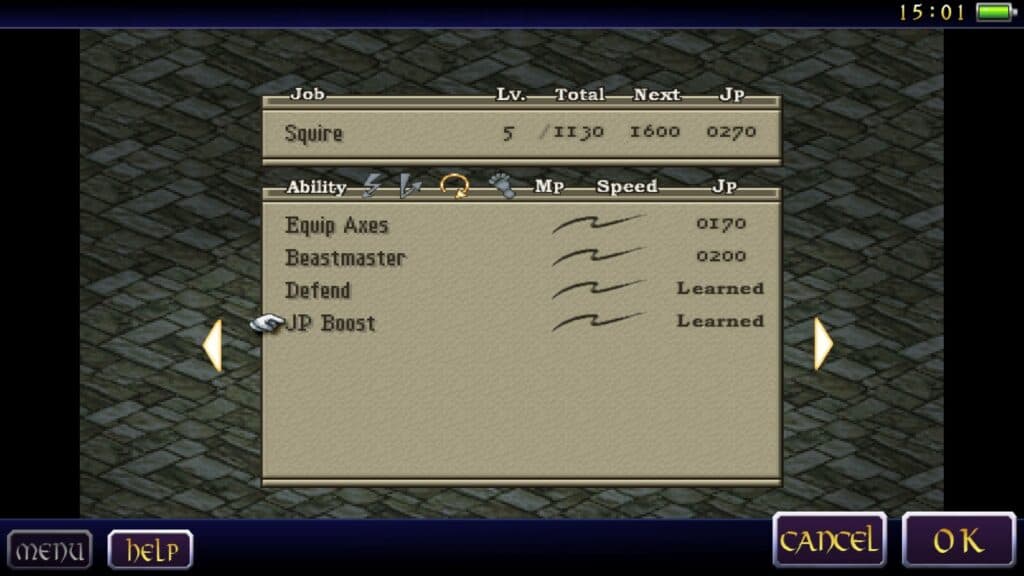
Speaking of, you can change jobs, equip items and learn abilities through the Party Roster screen by individually selecting one of the characters at your command.
The Monsters
There are a wide variety of cute and dangerous-looking monster sprites to battle and entice.
To get a lot of secret items and equipment, you’ll have to learn Poach in the Thief skill list. A character that equips this skill and lands the final strike on a monster, turns it to dust. This causes it to become one of a few possible items that will appear at merchant cities only in the Poacher’s Den.
Each monster presented to you has 3 versions. For instance; A Chocobo (A giant yellow bird you can ride in combat!) is the first, weakest version of its monster type. A Black Chocobo is the second version. A Red Chocobo is the third and strongest.
You can recruit a monster with the Orator Class Skill: Entice. Once in your Party Roster, as long as you have space open, they will lay eggs as you travel. These eggs will randomly hatch into either the same version or one stronger. (A Chocobo can lay a Black Chocobo egg).
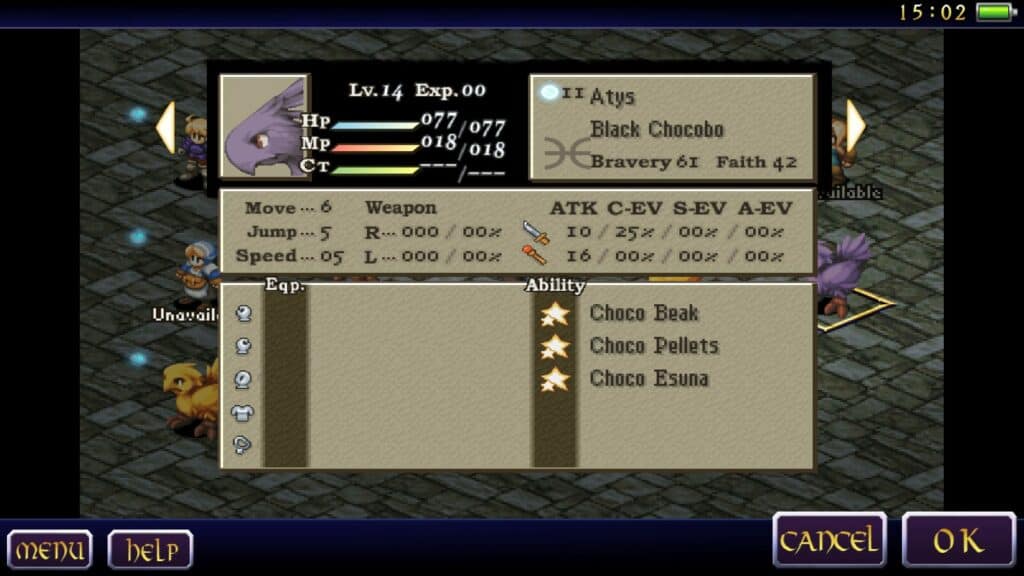
Using this tactic you can breed and poach monsters to collect otherwise very hard-to-find items. In some cases, like the pig, this is the only way to get the final version of that monster.
Combat
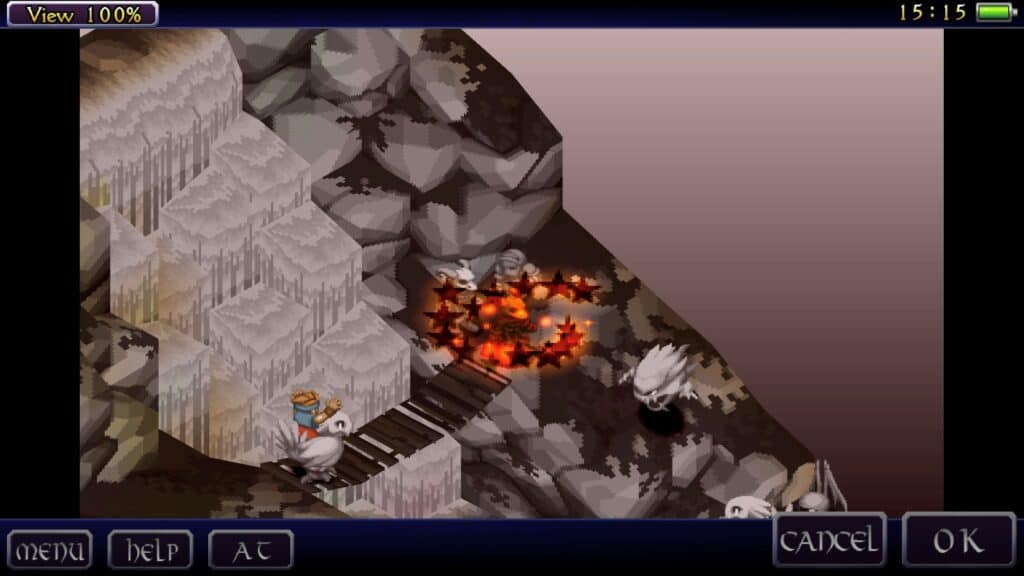
Actual combat is turn-based, each unit moving in order of its speed. If having the same speed they take turns going first each round. Positioning is important, stats like Move and Jump matter quite a lot in some maps.
As the game progresses all your characters will be able to choose from two lists of skills. Such as giving your Priest time magic or your Samurai geomancy.
When using skills, pay attention to their Charge Time, or CT. For normal movement and actions, these are related to the character’s speed stat, however…
Next to skills like Fire and Curaga, there is a number. That number is their CT. That will determine when it will go off in the Turn Order. So, if you are casting Fire on a Wild Cat, and Fire has a 4 next to it but that Wild Cat has a 3 next to it. It’s going to move before your magic is cast.
Friendly fire is on, so paying attention to the time your skills go off can be pretty important. Who you are going to hit in the blast radius of any one skill is shown by the squares highlighted in green.
Multi-Player
In those same Taverns found in every city, after you’ve reached a certain point in the story mode of the game, you can choose Rendezvous or Melee.
Melee is entering a PVP mode with other players, pitting your favorite team build against theirs.
Rendezvous lets you TEAM UP, combining your favorite teams to take on new missions, new maps, and unlock secret equipment.
Building a Unit
I’ve talked about the versatility of creation you have with the characters in your team, but what does that entail exactly?
Secondary Skill

Each Character has a secondary skill slot. Here they can choose to utilize one other list of skills from any job class they’ve unlocked. Giving you hundreds of combination choices by end game.
Counter Slot
Under the Secondary skill, you can assign any character a counter ability. Every Job class you choose has unique Counter abilities they can learn. The Archer learns Adrenaline Rush, for instance, causing you to increase your speed by one every time you get hit.
Once you have learned a Counter Skill from a job class you can equip it to your character no matter what class they become.
Boost Slot
Under the Counter Slot is the Boost slot. Like the Counter skill, the Boost Skills are gained from different job classes. A Knight can learn Equip Shield. This Boost Skill is useless for the Knight. However, equip this ability on a Wizard and now they can gain the benefits of a shield.
Movement Slot
The last slot you’ll notice is the movement slot. It is where you’ll unlock skills like Treasure Hunter and Teleport. In a game where terrain and planning play a large part in combat, good movement can be the key to victory.
Choosing a Job
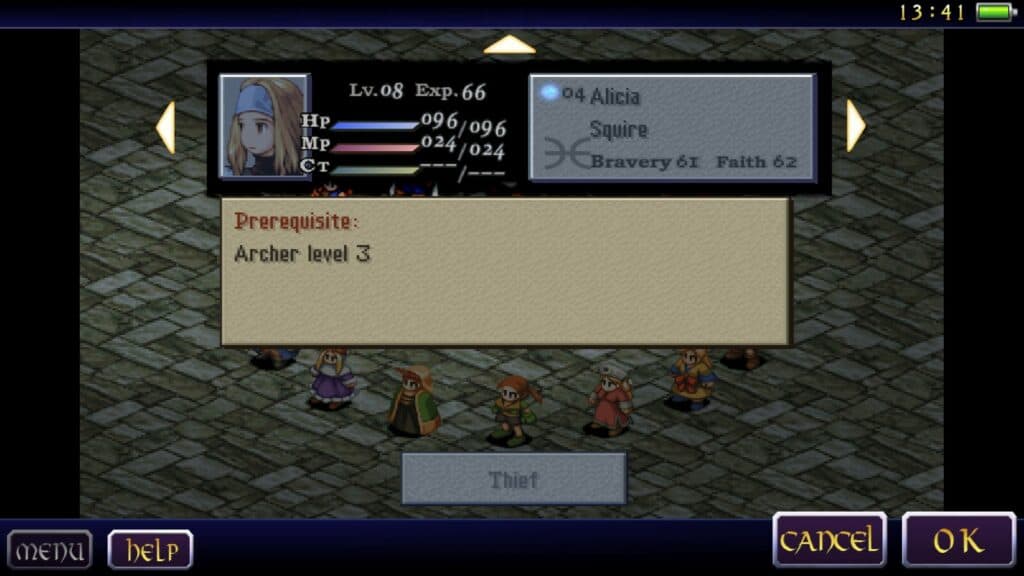
As you get more job points in one class that job will gain a level (Max.8). New classes will become unlocked as you level up more jobs. Mixing and matching skills between jobs to make your own hybrid hero is a joy I’ve yet to tire from.
Be Careful!
You need to know that characters can legitimately die in . If 3 of their turns pass while they are down and you haven’t revived them, that is gone forever. Only Guest characters are immune to this. Always have a way to revive a party member to save you from possibly rage quitting.
Any Tips to Help me When I Play?
Sure, I can give a few. Do check back through the article though, I hid some here and there.
Utilizing Death
When any monster dies, after 3 of their turns, they turn into a crystal. Picking up this crystal can heal your completely. If it was a human who died, however, picking up the crystal can let you learn any job skills they had that your didn’t, as long as they’ve unlocked that Job class.
Sticky Fingers
Sticky Fingers is a stupid Skill unless you’re item collecting. Once you are at max level, you sometimes get attacked by Ninjas in ARAGUAY WOODS. They throw some of the most powerful, rare weapons in the at you. With Sticky Fingers, you can catch them and they go right into your inventory!
Magic and Physical Attack
Don’t be tricked by certain skills like Samurai and Dancer. A Samurai’s abilities do damage equal to the magic attack of your and a Dancer’s does damage equal to their physical attack.
Speed is Special
Your Speed affects the chance you have to steal an item. Stealing items is the only way to get certain rare equipment, so it’s a pretty good set of skills to learn. Unlock the thief as soon as you can.
Your Speed also affects the time it takes to complete a Jump, the attack from the Dragoon class. It does not have any effect on Magic or Cloud’s skills. You must learn and equip Swiftness from the skill pool to expedite those.
Treasure Hunting
Using the Treasure Hunter skill is not a good idea unless you have a with extremely low Brave! The lower the Brave skill, the more likely they are to find a rare item where they walk.
Be Brave
The Brave rating is the chance of a successful counter skill activating as well as the damage of Monk skills and Knight Swords. Every 4 points it goes up in a results in a permanent one-point gain. (Maxes at 97)
You can raise the Brave stat with Ramza’s Steel or the Orator’s class Praise.
Faith
The Orator skill Preach can raise Faith. Faith directly affects the chance of a magic skill being successful as well as its damage.
At a certain point, a will leave your team if their Faith is too high, so don’t get greedy.
A low Faith can be utilized to make an ‘anti-magic’ fighter. Too low though, and they’ll leave the team as well.
FAQs
Question: Do I Need to Play Other Final Fantasy Games First?
Answer: Not at all. This game is a stand-alone title and a self-contained story.
Question: Is Final Fantasy Tactics the Best Final Fantasy Game?
Answer: It is certainly in my top 5, and I do encourage others to try it out.
Question: How is a Tactical RPG different than a Tactical Strategy game?
Answer: There’s less need to worry about upkeep and structures. Though the combat screens of many Tactical Strategy and Tactical RPG games are similar; in a Tactical RPG, each unit is not easily replaced by producing another. Your whole team is just heroes.
Question: Didn’t You Say I Could Poach Monsters From my Team?
Answer: There are exceptions to every rule.
Question: What Games are Similar to FFT?
Answer: Some great classic Tactical RPGs can be found in the Fire Emblem series. Fire Emblem: Path of Radiance comes to mind.
A newer tactical RPG title with a similar style is; GOD WARS The Complete Legend.
If you like the story elements of FFT and want more of that, I would suggest games like Suikoden and Vagrant Story.
Question: What are Some Other good Final Fantasy Games?
Answer: Each boasts its own style of character customization and a compelling plot.
Final Fantasy 7 is a good place to start. Final Fantasy 9 and Final Fantasy X are also some fan favorites.
FFXIV actually uses Ivalice as its backstory! You can see appearances from both Delita and Ramza! Which is fun.
Question: Is Final Fantasy Tactics a Good Game to Start within the Final Fantasy Series?
Answer: If your goal in playing a game is mainly to enjoy the storytelling, this is a great lead into how well stories can be told throughout the Final Fantasy Series.
If you are trying to feel how the games in the FF titles usually play, most of them are basic RPGs, and the gameplay in this game will be quite different.
Question: What’s bad About This Game?
Answer: Every game has its flaws.
Some characters don’t get the same love in the skill or stat department as others who had more impact on the story. I find this personally to be a poor development choice.
Question: Where Can I Play FF Tactics?
Answer: It is available on your phone as an App on the Apple Store and the Google Play store. Plus, the game, PlayStation X and PSP consoles are still available online.
Question: Will I like FF Tactics Even Though I Don’t Enjoy RPGs?
Answer: It is one of the better games to try if only for the story as it doesn’t punish those with no previous RPG experience as other titles might.
Question: Is the Story Hard to Follow?
Answer: Sometimes. Motivations are clear and the path is well laid out.
Question: Is FF Tactics Hard?
Answer: It isn’t outright easy. Trying to rush through this original game without learning how to customize your characters as the story evolves can lead to some crushing defeats.
Question: What’s the Hardest part of FF Tactics?
Answer: Status effects will become the most frustrating. The video game provides the player with a character named Orlandeau later on. This character makes the story battles quite easy for those who wish to focus on the story and not team optimization.
To Summarize
FFT is a standout among the tactical RPG genre, a unique title in the Final Fantasy Franchise, and a video game that holds vast replayability. The first playthrough, however, is better suited for taking in the story.
Because, Final Fantasy Tactics is, at its heart, a fantastic story.

